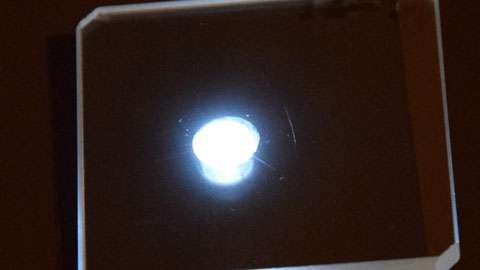New low-cost material for lighting and diagnostics produces white light imitating sunlight

Researchers at the University of Turku, Finland, have developed a synthetic material based on the natural hackmanite mineral, which produces broad spectrum white light in lamps. The low-cost hackmanite-based material created by the Inorganic Materials Chemistry research group emits luminescence closer to sunlight than currently used lanthanides.
The material contains only highly abundant and nontoxic elements, and therefore has low production costs and does not produce hazardous waste or contain health risks.
"The lower cost of the material is also a great asset in applications for diagnostics, as the lanthanides that are currently in use are expensive. Because of its persistent luminescence, hackmanite does not require expensive time-resolved spectrometers to measure luminescence," says Docent Mika Lastusaari from the University of Turku.
He believes that hackmanite has possible applications in point-of-care diagnostics because it is excitable with sunlight.
Lamps that produce white light imitating sunlight are used in lighting applications. Current fluorescent lamps and LEDs produce white light with luminescent materials that contain lanthanides, which is problematic. On the one hand, they are expensive and their price can vary a great deal and, on the other, they do not produce the same broad spectrum as sunlight. White light is produced with lanthanides by mixing three narrow-spectrum primary colours, red, green and blue, and therefore produce reflected light that does not meet the quality of reflected sunlight.
Hackmanite Produces Effective Afterglow
- "Persistent luminescence, also known as afterglow, is used in applications that glow in the dark, such as exit signs and watches. Our hackmanite material can produce observable white persistent luminescence for seven hours in the dark. With a spectrometer, the luminescence can be detected for more than 100 hours." says Lastusaari.
Until now, there have been no materials that produce good white persistent luminescence. Lastusaari says, "The hackmanite we have developed can be used in ordinary lamps as a single component phosphor to produce natural white light. As a bonus, hackmanite lamps continue to glow even after a power failure, thus being suitable for exit and emergency signs."
Hackmanite materials have excellent stability in water and the research group has shown that it has easily detectable photoluminescence even in nanomolar concentrations.
"We have also tested the material's application in diagnostics: we demonstrated that the material's persistent luminescence can be used in authenticating spices and testing for counterfeit foods. The tests were conducted together with the Detection Technology Group of the Department of Chemistry," Lastusaari says.
More information: Isabella Norrbo et al, Lanthanide and Heavy Metal Free Long White Persistent Luminescence from Ti Doped Li-Hackmanite: A Versatile, Low-Cost Material, Advanced Functional Materials (2017). DOI: 10.1002/adfm.201606547
Journal information: Advanced Functional Materials
Provided by University of Turku



















